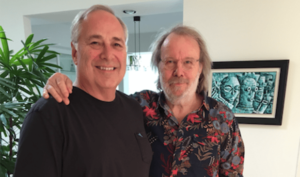
Inside the immersive mixes of Mamma Mia: Here We Go Again
Steve Harvey takes PSNEurope inside the Mamma Mia! sequel’s immersive mixes.
It’s been 10 years since the cinematic release of ABBA musical Mamma Mia! took the world by storm, and last month saw the release of its sequel, Mamma Mia! Here We Go Again, which has been wowing audiences across the board. Here, Steve Harvey takes PSNEurope inside the film’s immersive mixes…
More than 60 million people have seen Mamma Mia! in the theater since it premiered in London’s West End in 1999, with seven stage productions reportedly running worldwide at any given time. In 2008, the jukebox musical – based on some of Swedish pop band ABBA’s many hits – made the transition to the screen, smashing box office and sales records as it rolled out worldwide.
It remains the UK’s all-time best-selling DVD. Ten years on, here we go again. ABBA songsmiths Benny Andersson and Björn Ulvaeus have been involved in the show’s development since inception and were executive producers on the 2008 film version. Now the pair are back for the sequel, Mamma Mia! Here We Go Again. This time around, Andersson took the lead with the music, overseeing the re-recording of ABBA songs with the actors at London’s Abbey Road Studios and working alongside dialogue and music re-recording mixer Michael Minkler from start to finish.
The plan was to mix the film on Universal Pictures’ Stage 6, Minkler relates, but due to scheduling changes, he premixed the dialogue on the Avid S6 console at Pace Pictures. The recently opened facility, which features a Dolby Atmos stage that Minkler had a hand in designing, is in a former Soundelux building in Hollywood. Supervising sound editor Warren Shaw assumed effects re-recording mix duties on Stage 6, which features both a Harrison, a brand Universal has favored for at least 20 years, and an Avid console. “The S6 is permanently installed in two sections in the centre, but they still use the Harrison for routing and summing,” Minkler says.
The show’s sound effects editor, Dan Kenyon, ensured continuity by joining the mixers as stage editor. After years of experience with the immersive platform, Minkler is a fan of mixing in Dolby Atmos from the get-go. “You might as well start native Atmos, then it’s a very easy conversion down to 7.1 and 5.1,” he says. “Every time I do an Atmos mix the technology is different. Avid improves what they are making, Dolby is improving what they make. It’s almost like starting over every time.”
Despite the massive cast and the production challenges, the dialogue mix was nothing out of the ordinary, he reports. “There’s a lot of ADR in the movie. I was very happy with the way it fit in.” As with the original movie, which Minkler also mixed, the new sequel/prequel is all about the music. As Minkler notes, Andersson and his longtime studio collaborator, engineer, mixer and producer Bernard Löhr, as well as Andersson’s son Ludvig, a recording engineer and associate producer on this new film, are steeped in stereo.
“It was a learning process for Bernard and for Benny,” he says, noting that Andersson was present at the mix. “We mixed the songs as if we were in a 7.1 environment and made everyone happy. Then we took it into an Atmos room and played with it.”
Andersson and Löhr soon realised the possibilities afforded by Dolby Atmos, Minkler says. “Benny was very excited about it. His initial reaction was, ‘Oh my gosh, this is what I always wanted my music to be like.’” Ultimately, the music mix didn’t stray far from the original stereo versions, Minkler says. “We played with it and went to extremes and brought it back down. Bernard had his own mix room adjacent to our big mix room; when he got some ideas about pulling things apart, he would test those out in his room. “The music is basically a band, not an orchestra, so to pull the band apart so that different instruments are in different speakers, or different spaces within the room, wasn’t pleasing. We wanted to maintain a nice, tight mix, so the final result wasn’t wild and crazy,” Minkler adds.
That said, there were some opportunities to spread the vocals out in the immersive environment: “When the material was brought to the stage, Bernard had already put the vocals in a space that was correct for him. The music is mostly in the left-right of the room and the vocal is in the centre. The background vocals are spread left and right. They could be more towards the front, some towards the middle, some towards the back – it was a case-by-case process.”
As for the score, by composer Anne Dudley, he says, “that was always wider than the songs.” He adds, “Benny was a big part of that score, too; he worked with Anne on the tone.” With the songs having a specific sound and the live action scenes in their own acoustic environment, transitions could potentially be jarring. “But because this is Mamma Mia!, we didn’t hold as tight to those two worlds,” Minkler explains. “We could break out from the cinematic world into the musical world, and on occasion, we could distinctly breakaway. The film is so much fun, and the way it was directed, they can break into song and it’s OK.”
The mix team was busy with premixes and temp mixes for a seven-week period while the producers tested various cuts of the film, Minkler reports. The final mix took about three weeks.
Source: mi-pro.co.uk












